
Photo: Pixabay
Romania’s first independent air quality monitoring network, deployed by Philips Romania on October 1, 2018, has shown levels of PM10 and PM2.5 pollution frequently reaching seven to nine times the maximum allowed levels this winter.
The air quality network is continuously monitoring emissions of particulate matter PM10, PM2.5, and PM1 at 15 stations in Bucharest and Ploiesti, Wall-street.ro reported, as cited by Romania-Insider.com.
On December 2, the sensor located on Barbu Vacarescu Boulevard in Bucharest recorded a level of 373.3 micrograms per m3 at 8 pm for PM 10, more than seven times the legally allowed maximum. On December 2, the same sensor recorded a PM 2.5 concentration of 231.08 micrograms per m3 at 8 pm, which is more than nine times the legal maximum limit.
Under the World Health Organization’s (WHO) recommendations, PM10 and PM2.5 levels are recommended not to exceed 50 micrograms per m3 and 25 micrograms per m3, respectively, for a one-hour mean (the annual accepted means are lower), the portal wrote.
Air pollution sources include household heating systems, stoves, and solid fuel stations; the industry, thermal power plants, and construction sites; road traffic; and industrial and municipal landfills, according to a press release on Philips Romania’s website.
Air pollution excessive across the region
Air pollution is excessive across the region, especially in winter months.
In Bulgaria, air pollution from domestic heating and transport is a significant problem, with nearly 90% of the urban population exposed to excessive levels of PM10 in 2016, well above the EU average. Levels of fine particulates and benzo[a]pyrene also greatly exceeded target values in many towns and cities.
The European Commission has recently approved a EUR 16.7 million project to improve air quality in Bulgaria, with the EU contribution at nearly EUR 10 million. The project will be a catalyst for the mobilization of EU structural funding and national funds worth around EUR 1.4 billion in total to tackle polluting household heating in Bulgaria.
The WHO previously published data concerning mean concentrations of PM10 and PM2.5 for 2018, ranking Skopje, North Macedonia as Europe’s most polluted capital city.
Severe air pollution has even prompted Skopje to supply air purifiers for all high school classrooms this winter.
Air quality measurements by the US Embassy in Bosnia and Herzegovina (BiH) showed Sarajevo to be the world’s most polluted city a number of days in December 2018.
PM10, defined as inhalable particles with diameters generally 10 micrometers and smaller, is also the top air pollutant in Serbia, with all air quality monitoring stations in the country registering exceedances of the permitted daily limit value of 50 micrograms per cubic meter, according to the Serbian Environmental Protection Agency’s (SEPA) 2017 Annual Report on the Environment.


















Be the first one to comment on this article.